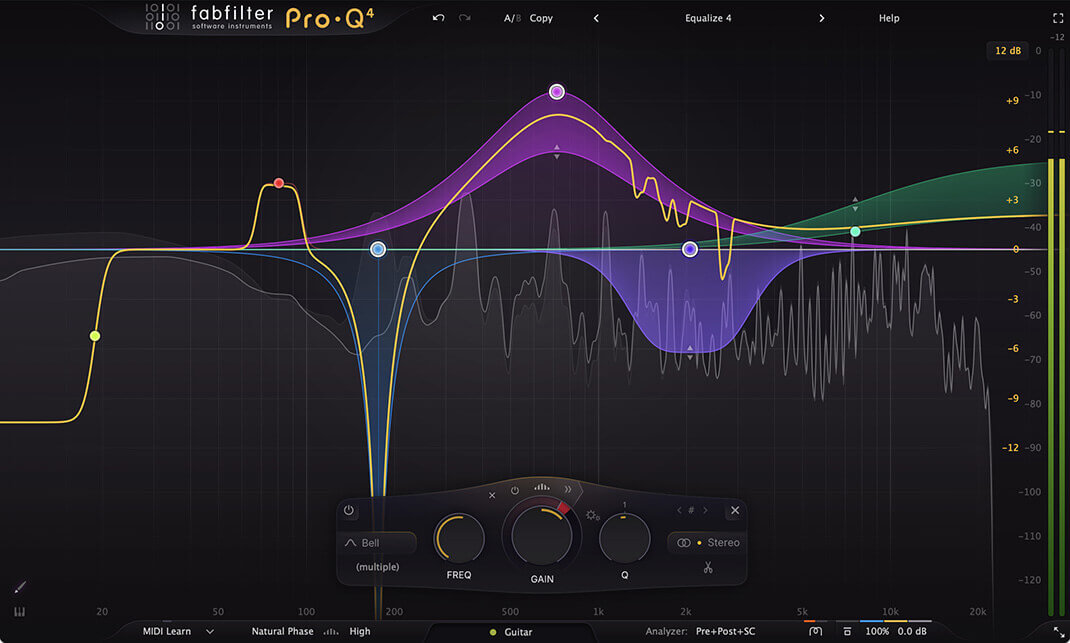Best Distortion Plugins
Welcome to my ranking of the best distortion plugins, which is updated frequently. For a long time, creators of music considered distortion to be the enemy since they wanted the purest mix possible. Analog circuitry is used to produce a distinctive organic sound. The norm was noise or mild distortion, which is indicative of the nature of analog technology. However, the advent of digital music production technologies brought with them an extremely clear sound devoid of noise and individuality.
One of the most effective methods to bring your digital audio to life is through analog emulation. These Plugins offer saturation to thicken, add warmth, draw pieces out of the mix, and create signature sounds. You may turn regular sounds into something utterly fresh and weird using some of these plugins. In general, when it comes to distortion, less is more!
For detailed specifications, please visit the linked websites of the manufacturers.
What Distortion Really Is – And Why It Matters in Modern Production
As a sound designer, distortion for me is more than just crunch and chaos – it’s a shaping tool, a character builder, sometimes even the secret sauce in a loop or one shot. While traditional engineers once saw distortion as a flaw, we’ve long since reclaimed it as an essential creative element. It’s about color, warmth, tension, or straight-up destruction when that’s the goal.
Distortion alters the waveform of a signal, usually by boosting it beyond its limits. This introduces clipping, adds harmonics, compresses dynamics, and creates everything from subtle saturation to complete sonic meltdown. Think tube warmth, tape grit, lo-fi fuzz, screaming filters, or tight, gritty overdrive – all under your control.
Distortion has evolved massively in plugin form. It now goes far beyond imitating analog gear: It can morph clean signals into textures, help elements cut through the mix, or glue things together in a way that feels alive and raw. Whether you want to fatten up a drum bus, dirty up a vocal, or reshape a synth into something weird and unique, distortion delivers.
Remember: It’s not about cranking everything to the max. Sometimes the best results come from subtle, almost imperceptible tweaks. Knowing when and how to use distortion – that’s where the artistry begins.
Kalifornia Dynamic – Alkane
Over the years, I’ve experimented with a ton of distortion and saturation plugins as a sound designer. Since it was their first release, I found their claim especially intriguing. They promised genuine analog warmth—something highly desired in digital audio workstations but often missing despite frequent marketing claims. Without a doubt, I’m happy to say that Alkane fulfills its promise and stands out in a crowded plugin market.
The Quality of Distortion
What immediately struck me was the feel of Alkane’s saturation: it’s incredibly rich, dense, and genuinely analog-like, without ever tipping into harshness or that unpleasant digitally
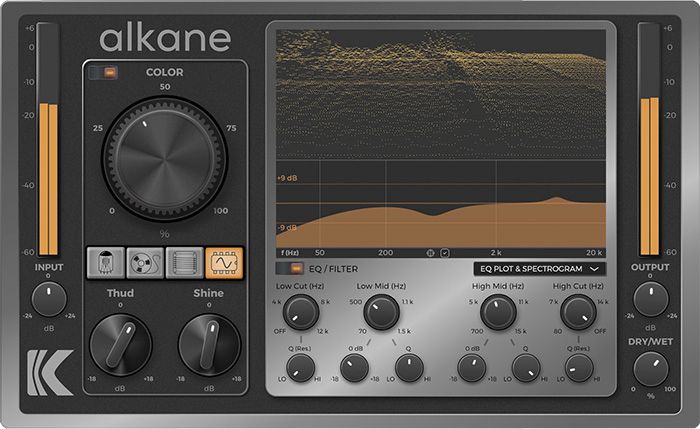
“overcooked” sound. Unlike so many saturation plugins that seem to overwhelm the source instantly, Alkane allows for incredibly fine, almost surgical adjustments. You can dial in even a tiny amount, and it feels meaningful and musical, not just a blanket effect.
While you can adjust with an EQ post-saturation, the signal is not split across four frequency bands for individual processing. Whether you’re working on individual elements or full mixes, Alkane maintains clarity, focus, and warmth in a way that few plugins can match.
There are 4 different circuits for the distortion styles: Tube, Tape, Transformer, and Synth. Once the circuit model is selected, then there is the Color knob to adjust the amount of saturation to be introduced from that particular circuit.
A crucial feature for my workflow, particularly with beat programming, is how Alkane handles transients and dynamics. Thanks to its Dynamic Saturation Engine and internal 8x oversampling, it preserves them beautifully, even when pushing the drive hard. I’ve heard countless distortion plugins that might do saturation, clipping, or tape emulation well, but often the punch or the initial attack gets lost in the process. That’s simply not the case here, which is a huge relief.
Not Just Another Saturation Plugin
Alkane’s feature set might seem “minimal” compared to heavyweights like FabFilter Saturn 2, Arturia Dist Coldfire, or Minimal Audio Rift, which offer vast modulation possibilities and complex sound design environments – a huge playground for sound design. You could easily assume that more features mean better value. But often I just want a perfect-sounding distortion unit. And that’s exactly where this tool comes into play.
In direct A/B comparisons focused purely on the quality of the distortion itself, I tend to Alkane. The depth, warmth, and natural behavior of its saturation are simply unique. It feels more like working with a boutique analog unit than with a digital plugin. Sometimes, less truly is more, and Alkane proves it by focusing entirely on sound quality over feature overload. Even my beloved Elektron Analog Heat will certainly be used less in the future.
Breathing New Life into my Loops
More than once, Alkane helped me breathe new life into loops and oneshots I considered “finished.” Just running material through it – even without extreme settings – revealed hidden textures and dimensions that I hadn’t heard before. Loops became more vivid, more three-dimensional, more alive. It’s rare that a plugin not only enhances a sound but also inspires new creative directions.
Innovative Features and User Interface
The plugin’s interface is both intuitive and visually informative. It gives you the tools you need without overwhelming you visually. It includes high-resolution visualizations such as a 3D Spectrogram (that looks simply spectacular!), EQ Plot, and Parameter Editor, facilitating precise monitoring and adjustments. There are different skins for each of the 4 saturation models. The inclusion of ‘Thud’ (adds low-end) and ‘Shine'(adds top end) controls offers super-easy to use additional tonal shaping. And yes, these two controls can bring your sound in the right direction within seconds. I really like the simplicity of Alkane!
Wishes for future updates
First, Alkane currently lacks automatic gain compensation, which would make level matching after saturation much easier. This function would be very important to be able to assess sound changes objectively. Second, the Post EQ section is controlled via knobs, and incorporating a graphical interface for direct manipulation of EQ curves would streamline the workflow. And ultimately, it’s not ideal that the sound changes slightly just by inserting the plugin, without changing any parameters. The low bass range, in particular, is already attenuated. A straightforward forward/backward button for preset selection would also be useful. To access the next preset, you currently need to enter the menu, which is a little inconvenient.
Final words
When it comes to sound design, mixing, or mastering, Alkane adds a depth and control that is incredibly captivating. It has a warm, genuine sound that is quite similar to analog. In fact, you could use it to make anything sound more focused and well-balanced. Despite its ease of use, there are numerous options to enhance the sound’s professionalism.
For the first plugin release from Kalifornia Dynamic, Alkane is an impressive accomplishment. I consider it a necessary tool for anyone who genuinely cares about the quality of their sound, and it has quickly established itself as a permanent fixture in my studio. Strongly advised!
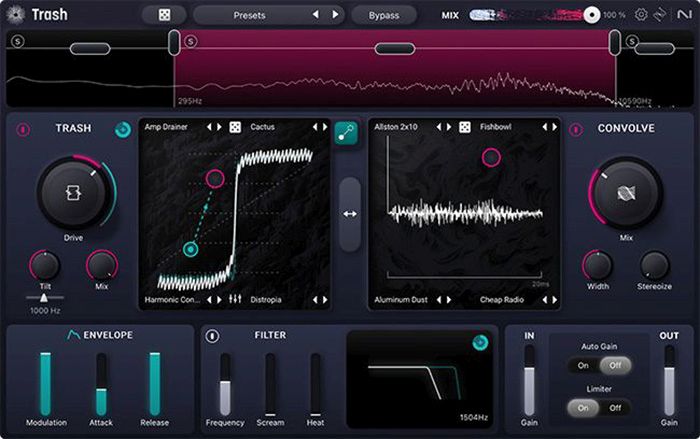
iZotope Trash
One of my all-time favorite plugins is Trash 2. With it, I have made countless insane loops and noises over the years that are nearly impossible to produce with any other tool. Simply put, you could easily destroy the signal. I found Ohmforce Ohmicide to be equally fascinating at the time.
Your attention is drawn to the new, sleek interface when you open the Trash. Without a doubt, this is a significant improvement over the previous version. But rather than being an update, Trash appears (and sounds) more like a different plugin, but tamed and calmer. Now to the details.
It makes use of two XY pads. You can move the effects in each corner of the pad to create different combinations of these four effects; when you enter a corner, you only get that one effect. The left side is called distortion, and the right side convolution.
The Trash module’s sixty distortion types have a pleasing sound. Not only does the X/Y Pad provide extensive automation options, but it also offers interesting possibilities with its >600 impulse responses (own import possible). These effects are all multiband, meaning that each of the three bands has independent controls. All of this provides you with a vast array of practical effects.
I think the extensive randomization is a great feature because Trash has multiple randomize buttons, which I find to be more flexible than on many other tools. They make it simple to identify a suitable place to start. It only took a few minutes of trial and error and fine-tuning for me to produce usable sounds. My creativity can be stimulated by this function.
For me, the new envelope follower is the standout feature. In this case, the modulation source is the input level. The global filter cutoff, the drive section, and the X/Y pad in the trash module are the three modulation targets. This enables you to let the filter snap open or close in time with the four loaded distortion algorithms and to switch between them dynamically.
Though I think Trash has a much better browser, having the ability to mark your own favorites would have been a great feature (Update?). With input and output gain controls, a limiter, and a distinct auto-gain function, iZotope has also considered gain structure. In my opinion, this solution is superior to the previous one, which frequently had drastic volume variations.
Sadly, there isn’t a sidechain signal available for use as a modulation source. Moreover, there is no step sequencer or LFO. Here, the competition like Rift or Coldfire provides far more options. Regretfully, the new Trash lacks some older features (like the Dynamics and delay section). More dramatic sound interventions were possible with the predecessor. The new Trash is a more moderate approach.
I also own Trash 2, and I think it makes sense to have both, particularly if you want to use the much better GUI with those XY blends and have those extra convolution sounds. Finally, I have to say that I like the new distortion types. They sound warm, authentic, and sometimes like they come from analog hardware devices. By the way, having this also on iPad is a great addition!
All in all, I personally would have liked a successor that would expand or perfect the fantastic possibilities of Trash2. But that’s mainly because I do sound design and would like to completely distort sounds.
Arturia Dist Coldfire
Dist COLDFIRE is a contemporary audio effect plug-in that provides the traditional distortion effect along with entirely new features.
This is where two distinct distortion algorithms can be mixed and matched. In addition to flexible routings (series, parallel, mid-side, band split, etc.), there are 33 distinct algorithms available. For every distortion slot, there are additional modules that include a compressor, limiter, multiband compressor, and feedback function. Not to be overlooked, there is a sophisticated modulation section as well. Up to six slots can be used to combine LFOs, envelope followers, 16-step sequencers, and other functions.
Once more, there are two graphical views: “normal” and “advanced.”
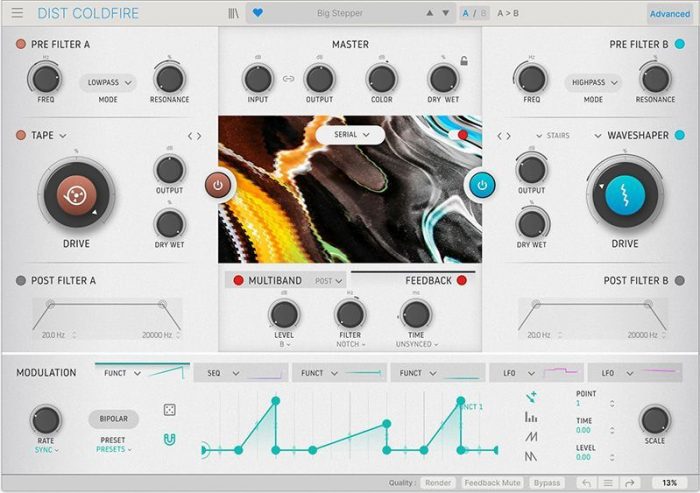
The many and amazing presets can be specifically searched using the search function. Furthermore, you can sort them by tags, type, genres/styles, or banks. Excellent work. In addition, the A/B mode is very useful, allowing you to compare two different settings with just one click. Moreover, the mouse click history feature lets you retrace all your actions. You can go back and forth as needed, which greatly improves workflow transparency.
Initially, I didn’t see the need for another distortion plugin. After all, I already had plenty of distortion tools, tape saturators, tube effects, and other saturators in the studio. However, once I tried Coldfire, I quickly realized it truly enhanced my setup. As a result, things turned out quite differently. Coldfire can be used very experimentally and subtly—or wildly and aggressively. In either case, the outcomes are consistently compelling.
In my opinion, Dist COLDFIRE takes Arturia to a whole new level. Its usability and interface polish are unparalleled. Especially for sound designers, it offers a novel and refreshing way to create, rather than merely replicate old hardware. Notably, the modulation options can drastically reshape your sound in creative and unexpected ways.
Even more impressive, Coldfire can transform fairly boring-sounding drum loops into grooves that fit perfectly into modern Techno productions. This is my go-to tool when creating sample libraries. No matter how ordinary a sound may seem, you can easily give it a unique and contemporary character. For instance, using the band-split mode, you can combine digital and analog distortion types. This way, you can add digital power to the highs while warming up the lows with analog emulation.
Ultimately, the tool goes far beyond simple distortion. Its ability to completely reshape audio through precise interventions sets it apart. This isn’t just another distortion plugin. For those who appreciate vintage gear, coloration, and unique sonic textures, Coldfire offers far more than a typical all-in-one processor. Thanks to its excellent controls, distinctive sound, and staggering variety of options, it clearly stands among the most feature-rich distortion plugins available today.
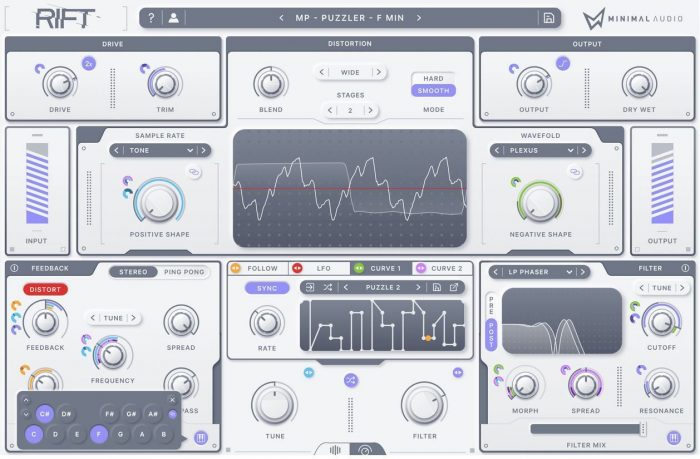
Minimal Audio Rift
The young company Minimal Audio has released a truly futuristic shaping plug-in called Rift. It combines a multi-algorithm distortion, a multimode morphing stereo filter, extensive modulation, and a delay/feedback combination. Shortly after testing Riff for the first time, I was impressed with how deep its functionality goes.
What sets Riff apart from the competition is its bi-polar processing engine. It’s a technique for separating the positive (upper) and negative (lower) parts of a waveform and distorting and modifying them independently. The two are then combined in different ways and edited separately. Waveshapers, wavefolders, noise, bit-crushers, and sample rate reducers are among the 30 unique algorithms included in Rift’s sophisticated distortion engine.
Delays, distorted feedback, chorus and flanger-like modulation, resonators, and even frequency/note-tuned feedback are all available under the Feedback section. As crazy as that may sound, the feedback rate can be adjusted in notes, Hz, milliseconds, and BPM-synchronized note divisions. Using the Pitch Snap tool, you can quantize the Frequency parameter to notes and scales. This allows you to play and modulate melodies. I’ve never heard anything like it. Just impressive!
Rift allows you to fine-tune every aspect of the game. Also, transposition, MIDI tracking, 24 stereo filter types, sophisticated curve sequencing are included. Over 400 impressive and well-structured presets provide a good basis for your own creations. I love to heat up my drum-, bass- and synth loops with this powerful sound design tool. Even with originally boring static tones, the results sound extremely interesting. This company’s debut is just impressive and Rift is a must-have!
Fabfilter Saturn 2
Saturn 2 is a highly versatile distortion plugin that offers everything from subtle, clean, and warm saturation to utter harmonic annihilation.
V2 comes with a redesigned easy-to-use GUI (five UI sizes) with modulation visualization, 16 new distortion algorithms (28 in total), multi-band and side-chain operation, an adjustable slope for the crossovers, offering 6, 12, 24, and 48 dB/oct options, a new Transformer category, ergonomic improvements and more.
I have many distortion effects installed on my system. Saturn, more than any other Plugin, I believe, covers natural-sounding and subtle distortion the best. FabFilter Saturn 2 delivers everything from subtle, clean, and warm tube or tape saturation to the wildest multiband
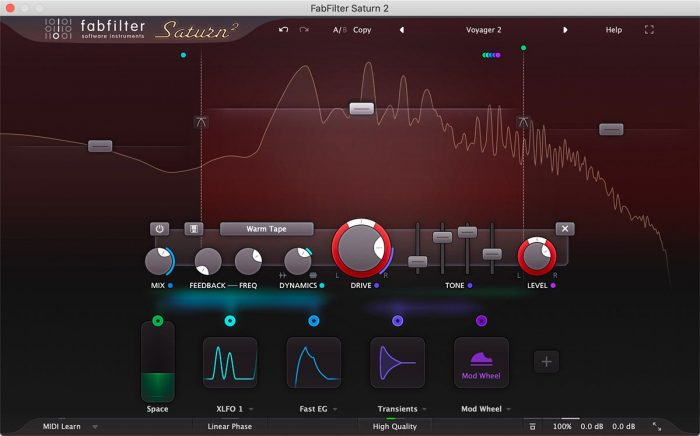
guitar amp effects. Saturn 2 is versatile, with an easy-to-use user interface and a wide range of modulation options that sound fantastic. There are so many options for modifying sounds! I like to use it on almost everything. The preset “Faster Master” is an insider tip!
I can’t recommend Saturn 2 highly enough if you’re looking for a multiband distortion plugin for mixing and sound design. Saturn 2 is definitely one of the best distortion plugins.
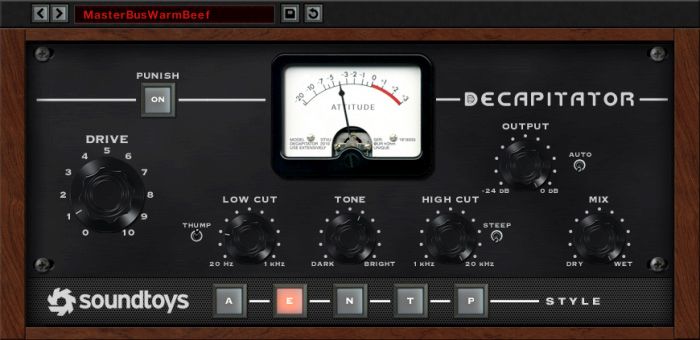
Soundtoys Decapitator
Decapitator is ideal for adding character to any track or instrument in your mix, with five different analog saturation models to pick from. There’s also a modeled tone control for shaping the saturated sound, as well as a mix control for blending in some dry signal for parallel processing without the need for routing and sub-mixes.
When you combine all of this with the versatility and dependability of a Soundtoys plug-in, you’ve got the best of both analog and digital in one indispensable effect.
This tool is capable of producing a wide range of harmonic tastes. Decapitator was released in 2009 and is now quite limited in terms of options compared to the competition. After all those years, I don’t use it that often anymore. If I didn’t have a tool of this type, I would use Saturn 2, Rift, or Dist Coldfire. The possibilities these newer tools offer are simply far better. Decapitator is also included in the Soundtoys Bundle, where you get other very good-sounding tools. You have to estimate what you need.
Black Box Analog Design HG-2
With this updated version of the widely regarded Black Box plug-in, you can add tailored analogue-style saturation to in-the-box mixes.
Before Black Box Analog Design teamed up with Brainworx to develop the software modeling, the HG-2 was already a highly coveted analogue

hardware unit. It offers a lovely analogue sound that ranges from gentle to harsh, with a wide range of harmonic tones. The M/S and new filters give you a lot more options. Black Box HG-2 adds volume while maintaining impact. It’s a great example of what may happen when a developer pushes the boundaries of hardware emulation.
I think it’s difficult to see how anyone could be disappointed with this. It’s not inexpensive, but it’s a steal for what it does. You can get it for a lot less money in the regular sales or as part of a subscription bundle, like with all Plugin Alliance software. The HG-2MS is a multicolored swiss army knife and typically used on the mix bus.
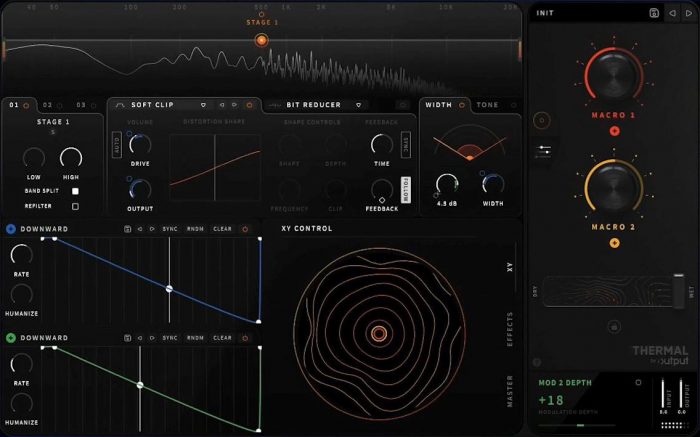
Output Thermal
Output is currently one of the most daring and forward-thinking plug-in designers on the market. This Parallel Distortion Processor has 3 distortion and effects stages, 19 distortion kinds, 9 effects types, effects, and master effects sections, as well as 2 adjustable envelopes and 2 macros with X/Y control.
The multi-layer sound engine, which can be controlled using the X/Y control interface, is at the heart of the plug-in. Thermal has around 250 fantastic presets, all of which are organized in a nice preset browser.
It’s a great creative tool for more drastic destruction and less for soulful fattening.
Thermal is convincing all along the line and is simply fun. The presets assigned to the instrument groups inspire right away. Unfortunately, the price is relatively high.
iZotope Ozone 9 – Vintage Tape
The Vintage Tape module is a great go-to for standard saturation duties while mixing and mastering. It’s available in iZotope’s mastering suites Ozone 9 Standard and Ozone 9 Advanced, and it can also be loaded as a separate plugin in Advanced.
The tape speed, Bias (for setting the saturation response), Harmonics, and smooth high and low-end EQ bumps with the Emphasis sliders are all stripped-down but highly well-considered controls.
Ozone’s modern, super-clean interface and clear controls, which are modeled after the Studer A810 analogue tape machine, will be especially appreciated by anyone who wants the desirable sound of classic hardware without getting sidetracked by the often strange and completely
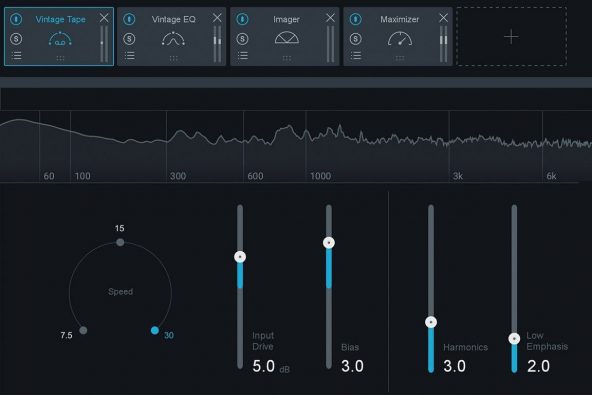
unintuitive quirks of the old machines and their controls, quirks that are usually — for some reason. Overall, I enjoy the plugin’s ‘careful’ approach to tape, and I find it handy in nuanced or sensitive applications where you just want to do a ‘few’ things to the signal at a time.
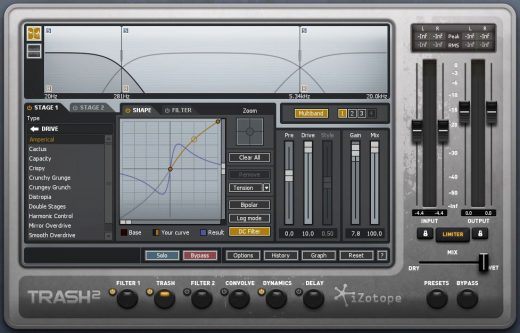
iZotope Trash 2 (DISCONTINUED!)
It’s important to note that this isn’t just another distortion tool. Trash 2 by iZotope, which was released in 2012, is still considered a benchmark in the world of complex distortion plug-ins. This one has a lot of interesting features, and it appears to blend all of the stuff’s rough analog and nerdy digital subtleties into a tweaker’s delight.
Trash2 can do everything from mild tube saturation to over-the-top bit crushing and completely bizarre effects. This beast offers more than 60 distortion algorithms, 6 multi-effect modules, a breathtaking multiband waveshaper, and more than 100 presets.
Its sonic versatility for creative production with sophisticated filtering and
dynamics effects plus realistic speaker and space simulation leaves no wish unfulfilled. Trash2 is wonderful for giving lifeless sounds their own personality. You can dramatically transform any sound into something completely different. It’s an indispensable tool in my arsenal.
You can get your hands on a Distortion Plugin for a little money. It’s a lot more powerful than the one that came with your DAW. Trash2 is one of the best distortion plugins out there!
D16 Devastor 2
Devastor 2 by D16 Group is a multi-band distortion effect plugin with a lot of options for distorting your sound source in various ways. The strong diode clipper with 6 distortion curve types, customizable parallel, pre, and post signal routing, and the new master output limiter are among Devastor 2’s primary features. It’s broken up into 3 main sections: Distortion Shaping, Signal routing and filters and Output and Limiter.

Devastor 2 is a formidable weapon with various uses in any genre, whether it’s employed for stylized mixing effects (broken radios, damaged microhones, etc. ), signal-crunching etc. I also recommend D16 Group Devastor 2 for kickdrum distortion as you can specifically edit various frequencies here. To crossfade between a completely wet signal and a dry signal, use the dry/wet knob. This enables the effect to be processed in parallel with the dry signal.
This multiband distortion effect also strikes an excellent mix between quality and cost. So if you want to give your song a distinctive taste, Devastor 2 is a great choice and one of the best distortion plugins.
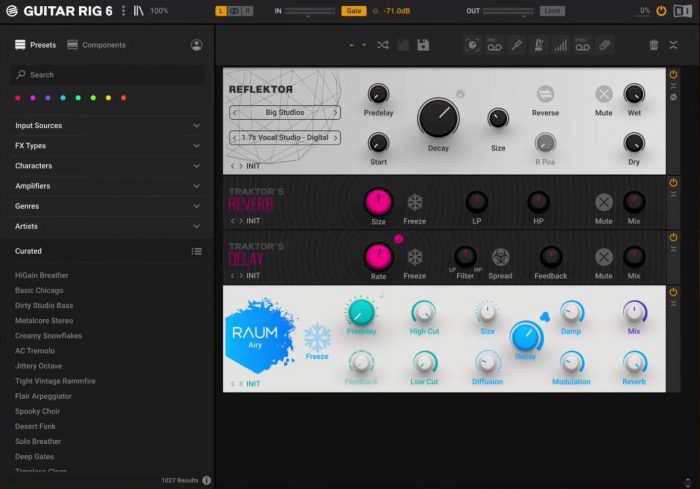
Native Instruments Guitar Rig 6
Even though I’m not a guitarist, I enjoy using NI Guitar Rig 6 for my sound design. Every Komplete user has this interesting tool anyway. I send all sorts of signals through Guitar Rig. Be it drum loops, vocals, synth loops, atmos sound, etc.
Guitar Rig offers a large number of effect modules, as well as sophisticated routing and modulation options. By simply stepping through the presets, you can often get stunning and unexpected results. A notably unique tone is created after some final careful tweaking.
The integration of many NI products such as the Mod Pack (Choral, Flair, Freak, and Phasis), various reverbs, compressors and more makes the plugin very versatile. The effects from the tractor’s 12 series are particularly noteworthy
In a short amount of time, you can come up with some interesting rhythms. The mix of a modern style and simple functioning has proven to be incredibly successful. The tool has applications far beyond guitar and is, in my opinion, a superb sound design construction kit.
XLN Audio RC-20 Retro Color
It has never been easier to make audio noisy, wonky, and analog than these unique recordings from the past.
RC-20 Retro Color comes with 6 effect modules: Noise Generator, Wobble & Flutter, Saturation & Distortion, Dedgrader & Bitcrusher, Reverb, and Volume Drops. This audio weapon gives any track or mix an analogue, gritty, fat, noisy, alive, and organic sound. Because analog sound is inherently chaotic, each module has a flux parameter that randomizes the settings and hence causes havoc.
I use it for subtle texture, filtering, pitch warp, and gain character but also in extreme settings when the original signal is to be completely changed. It breathes life into digital sounds! In the past, I’ve accomplished this by combining a number of different plugins. However, achieving an acceptable result has not always been straightforward. Those days, however, are no longer.
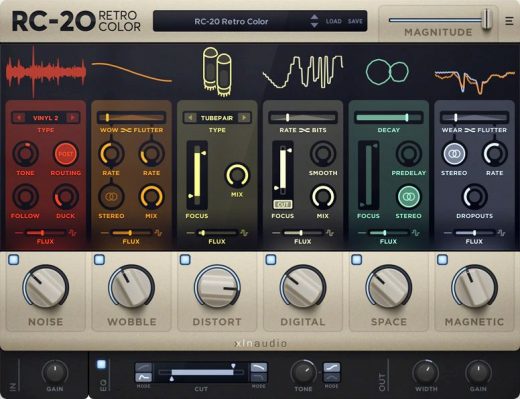
One of the best Distortion Plugins available is RC-20 Retro Color. In my arsenal on a regular basis!
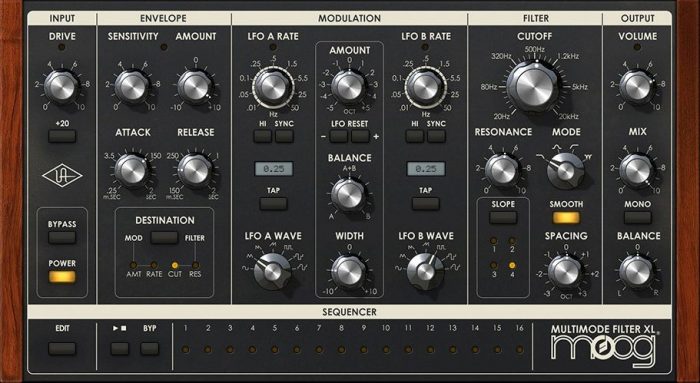
Moog Multimode Filter XL
One of the best purchases I’ve made for my UAD system is the Moog Multimode Filter.
Applying perfectly authentic fuzzy vintage Moog filtering and saturation to stereo sources was never that easy. This excellent, highly versatile musical filter is suitable for almost any application.
This is the solution if you want to give your VSTi synths a wonderful analogue touch, richness, character, and personality like the original hardware.
My samples will have precisely the right analogue edge thanks to the unique drive feature. You can really go crazy with the step sequencer because it opens up a world of possibilities with Moog filtration that is wonderfully velvety. When it comes to high-end saturation, this excellent tool is one of my favorite VST plugins.
U-He Satin
It’s good to add some color and depth to the overall sound in this day of pure, transparent, sharp digital.
Satin puts the tape recording legacy in your hands. You can control both the good (saturation, transient smoothing, compression) and bad (noise modulation, flutter, hiss) aspects. Build the (im)perfect tape machine.
Satin is an excellent reproduction of the prized tape sound. From modest warming to multitrack glueing, this highly tweakable tape emulation has a wide range of uses. Input Gain (Saturation), Tape Speed (Frequency), and Tape Model (Character) are the most essential parameters. It offers a simple interface with well-organized presets. Satin also incorporates noise reduction circuitry and outstanding delay and flanging. The group option is useful for gluing tracks together and can be used across all tracks.
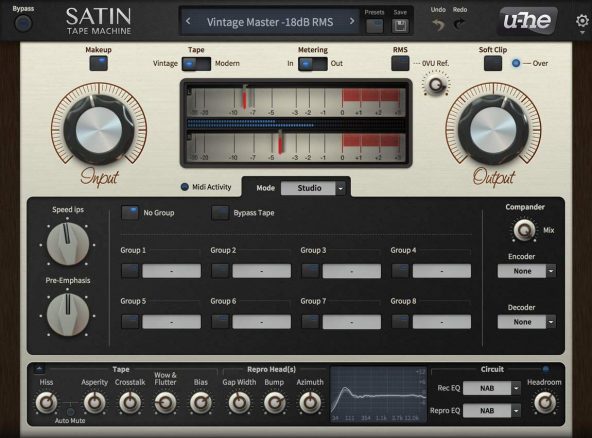
Personally, I like to use it in my drum group to tie the sound together or give the various samples from different sources a distinct contour. Aside from that, I frequently use it on the Send Effects (Reverb, Delay, etc). When it comes to Demo Producing for my Sample Packs, I also apply Satin very lightly on the master stereo bus. This is how I get the final tape sheen.
Satin is excellent for warming up, gluing together, compressing and coloring your digital DAW production. This is, without a doubt, one of the most complex and versatile tape-based plugins available.
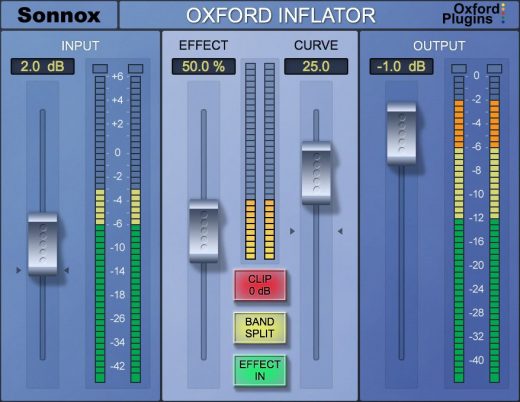
Sonnox Oxford Inflator
The Sonnox Inflator has been on the market for about 2 decades. The plugin isn’t quite like the standard saturation plugins for tape and tube simulation. It’s been a type of hidden weapon.
The Inflator comes into play if traditional compression and saturation tools and settings result in undesirable pumping and coloring.
It has the remarkable capacity to make practically everything louder, independent of the remaining dynamic range or the amount of compression used earlier. Going even further, the Inflator may mimic the flavor and dynamic excitement of analog systems that our ears are familiar with.
If you want strength, warmth, and modern presence – hallmarks of great saturation – and still need transparent processing, the Inflator delivers exactly that. Its simple interface makes it one of the best distortion plugins available.
OhmForce Ohmicide: Melohman
Ohmicide is an inspiring beast of a plugin. It’s just different. Even though this multiband distortion plugin has been available for many years, I still enjoy using it because the results keep surprising me.
This slightly CPU-hungry tool offers more than 80 distortion models, ranging from minor to insane. You have a lot of control over the size of each band, as well as the gain, spread, shape, and several other parameters within each band. The ability to morph between presets via MIDI increases the fun factor and creativity enormously.
It features a wacky user interface, a unique sound, and a ton of adjustment possibilities. The amount of tone variation you can get is amazing. The feedback function is a real treat for the ears!
I always get lost in sound when I use it. In addition it’s also a fantastic for sound design. Oh yes, Ohmicide is a unique sound killer and one of the best distortion plugins available.
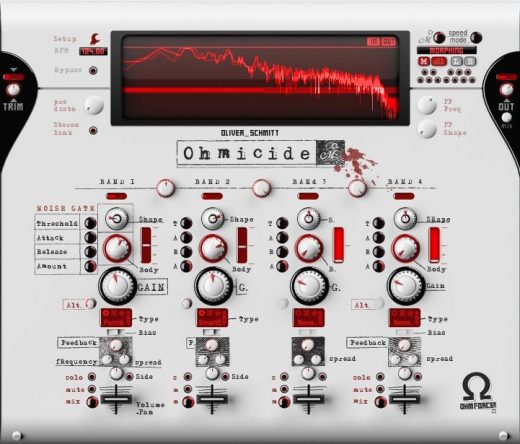
This was my personal list of the best distortion plugins that I use to create my sample packs. I will update this category regularly.







